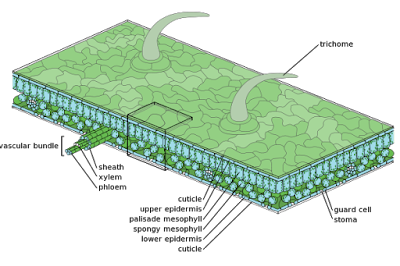Epidermal Tissue System in Plants
 |
| Leaf Structure and Epidermis (image credits: wikimedia) |
1. The outer covering of the plant body is formed of epidermal tissue system.
2. The epidermal tissue system is composed of
ⅰ epidermal cells,
ⅱ stomata and
ⅲ edidermal appendages (trichomes and hairs).
3. Epidermis: The outermost layer of the primary plant body is called epidermis.
4. The epidermis is made up of elongated, compactly arranged cells. These cells form a continuous layer. There is usually a single layer of cells in the epidermis.
5. The epidermal cells are parenchymatous. In these cells, a small amount of cytoplasm lines the cell wall and a large vacuole is present.
6. The outer surface of epidermis is usually covered with a waxy cuticle. The cuticle prevents the loss of water. However, cuticle is absent in roots.
7. Stomata: The minute pores present in the epidermis of leaves are called stomata.
8. A stoma is composed of two guard cells; which are bean-shaped. The guard cells are dumbbell-shaped in grasses.
9. The outer wall of guard cells is thin and the inner walls are highly thickened. Chloroplast is present in the guard cells.
10. The guard cells regulate the opening and closing of stomata. A few specialized epidermal cells
may be present near the guard cells. These specialized cells are called subsidiary cells.
11. The stomatal aperture, guard cells and subsidiary cells together make the stomatal apparatus. Transpiration and exchange of gases are regulated by stomata.
12. Casparian Strips: The Tangential as well as radial walls of endodermal cells of dicot roots have deposition of water impermeable, waxy material–Suberin in the form of casparian strips.
13. Hairs: The root hairs are unicellular elongations of the epidermal cells. They absorb water and minerals from the soil.
14. The epidermal hairs on stem are called trichomes. The trichomes are usually multicellular.
They can be branched or unbranched. They can be soft or stiff.
15. The trichomes prevent water loss through transpiration. Some of the trichomes may be secretory.


No comments:
Post a Comment
We love to hear your thoughts about this post!
Note: only a member of this blog may post a comment.